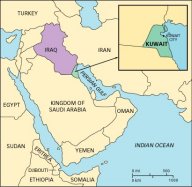


Page 3 of 4
In what may have been an attempt to reconcile this paradox (that the outcome of his actions always seemed to be the opposite of his stated objectives) Saddam Hussein announced on 12th August that, if Israel would withdraw from the occupied territories, he would withdraw from Kuwait. While the United States undoubtedly applies a double standard in the Middle East where Israel is concerned, Saddam Hussein’s attempt at “linkage” (linking the question of his occupation of Kuwait with Israel’s occupation of Arab lands), in the circumstances, was nothing more than rhetoric aimed at Arab popular sentiment.
As the multinational forces assembled, the United States was meticulous in ensuring that it was acting in conformity with the provisions of the United Nations charter. In parallel, the United Nations, other organizations and individual countries launched a number of diplomatic initiatives to resolve the problem without the use of force. Reports of atrocities perpetrated by Iraqi troops in Kuwait served to stiffen the resolve of all members of the alliance to expel Saddam’s forces and confirmed the wisdom of King Fahd’s decision to enlist international help to liberate Kuwait.
In order to ensure that the alliance was acting with United Nations authority, on 29th November the United States drafted a resolution which, in essence, declared that if Iraq had not fully complied with earlier United Nations resolutions demanding its withdrawal from Kuwait by 15th January 1991, the alliance could use “all necessary means” to compel compliance. This resolution (No 678) was adopted.

